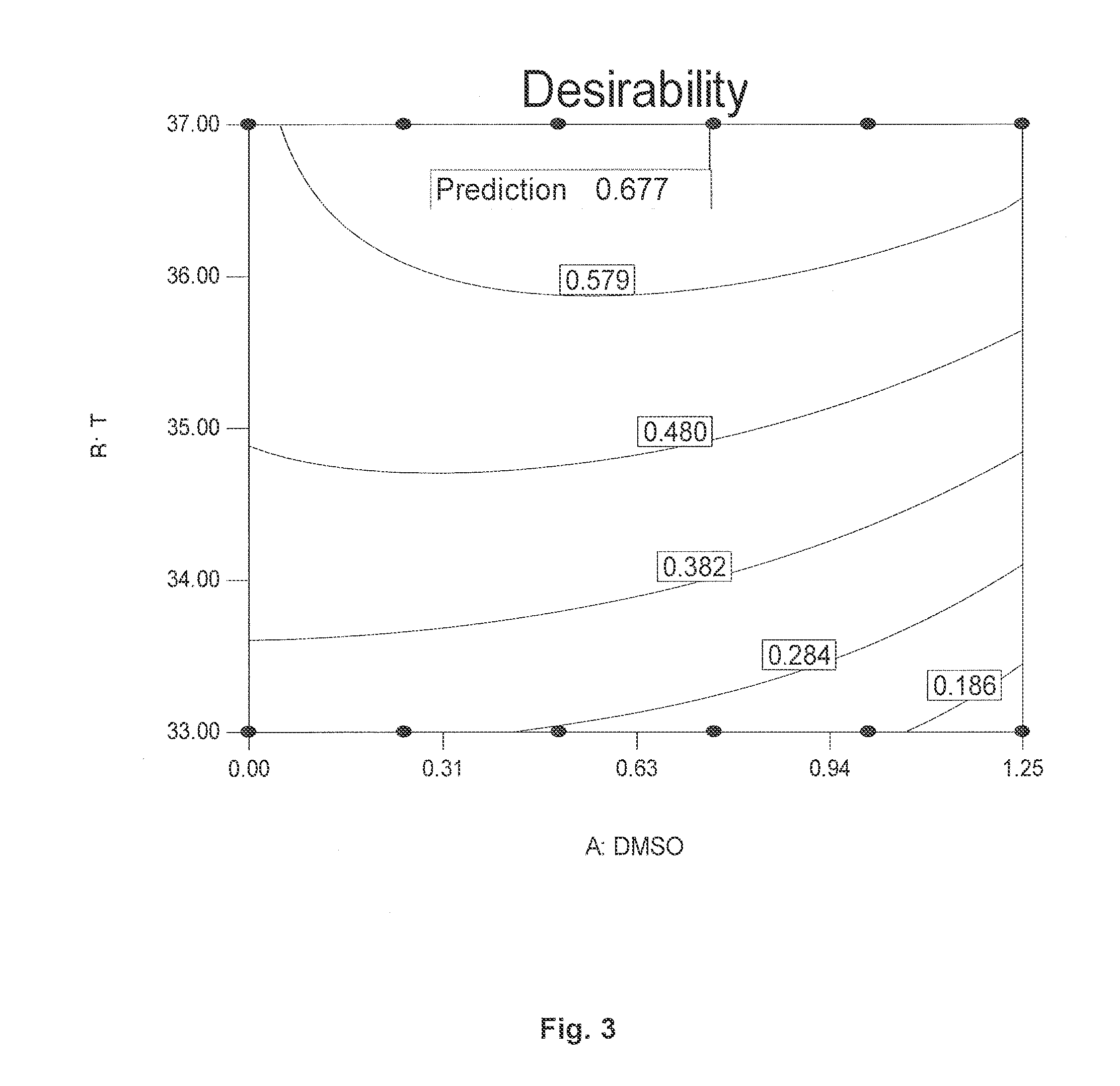Production of glycoproteins with low n-glycolylneuraminic acid (neu5gc) content
- Summary
- Abstract
- Description
- Claims
- Application Information
AI Technical Summary
Benefits of technology
Problems solved by technology
Method used
Image
Examples
example 1
General Experimental Setting
[0088]Recombinant CHO cells expressing high titres of the glycosylated human glycoproteins were cultivated in suspension culture using rich in-house standard medium without additives according to the invention. After 2 weeks of passages, the cells were first harvested and subsequently inoculated into the same medium, however, supplemented with a range of DMSO concentrations from 0.25% to 1.50% (w / v). The effect of DMSO on growth, productivity, degree of sialylation, and Neu5Gc content was studied.
[0089]“One factor at the time”-experiments with different DMSO concentrations at 37° C. and 33° C., respectively, were performed at first in an attempt to determine the DMSO concentration and temperature which are best to minimise the Neu5Gc content on the glycoproteins secreted. To study the interaction between the parameters (i) DMSO concentration, (ii) time of DMSO addition, and (iii) time of the temperature shift (from 37° C. to 33° C.), further experiments w...
example 2
Determination of the Concentration of the Secreted Glycoproteins
[0092]The concentration of the secreted glycoproteins was quantified using an enzyme linked immunosorbent assay kit from R&D Systems (R&D Systems, Inc., Minneapolis, Minn., USA) according to the manufacturer's instructions. Microplate wells, pre-coated with monoclonal (mouse) antibodies specific for the respective glycoproteins expressed were first incubated with standard blank samples and specimens. After removal of excess solution, the wells were incubated with anti-glycoprotein polyclonal antibodies conjugated to HRP (horseradish peroxidase). During the second incubation, the complexes formed between antibody-enzyme conjugates and the immobilised glycoproteins and the excess conjugates were removed by washing, followed by the addition of a chromogen. Oxidation by HRP resulted in a coloured complex (blue). The reaction was stopped by the addition of acid, which causes a change of the colour from blue to yellow. The ab...
example 3
Purification of the Secreted Glycoproteins
[0093]At the end of the batch culture the cells were removed. The glycoproteins were purified from the remaining harvests by means of immuno-affinity chromatography. Briefly, up to 2 mg of each of the glycoproteins per ml of the chromatographic resin (20-500 ml of the harvest) were loaded onto the column. Elution of the glycoproteins was performed with 0.1 M Na-phosphate buffer, pH 2.5. By adding 1 M Na-phosphate buffer, pH 7.5 (made up by a combination of Na2H-phosphate and NaH2-phosphate), the pH of the eluate was immediately adjusted to 7 and then stored for further analysis at below −60° C.
[0094]For determining the glycoprotein concentration in purified samples, RP-HPLC was used. Chromatographic separation of the respective glycoprotein from other (contaminating) components was based on the differences in their hydrophobicity, and the glycoprotein concentration of the samples analysed was determined by comparing the response obtained wit...
PUM
| Property | Measurement | Unit |
|---|---|---|
| Temperature | aaaaa | aaaaa |
| Temperature | aaaaa | aaaaa |
Abstract
Description
Claims
Application Information
 Login to View More
Login to View More - R&D
- Intellectual Property
- Life Sciences
- Materials
- Tech Scout
- Unparalleled Data Quality
- Higher Quality Content
- 60% Fewer Hallucinations
Browse by: Latest US Patents, China's latest patents, Technical Efficacy Thesaurus, Application Domain, Technology Topic, Popular Technical Reports.
© 2025 PatSnap. All rights reserved.Legal|Privacy policy|Modern Slavery Act Transparency Statement|Sitemap|About US| Contact US: help@patsnap.com



